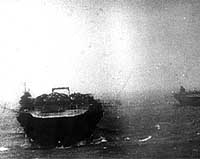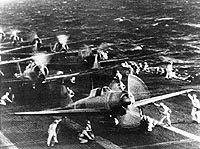
The Pearl Harbor naval base was recognized by both the Japanese and the United States Navies as a potential target for hostile carrier air power. The U.S. Navy had even explored the issue during some of its interwar "Fleet Problems". However, its distance from Japan and shallow harbor, the certainty that Japan's navy would have many other pressing needs for its aircraft carriers in the event of war, and a belief that intelligence would provide warning, persuaded senior U.S. officers that the prospect of an attack on Pearl Harbor could be safely discounted.
During the interwar period, the Japanese had reached similar conclusions. However, their pressing need for secure flanks during the planned offensive into Southeast Asia and the East Indies spurred the dynamic commander of the Japanese Combined Fleet, Admiral Isoroku Yamamoto, to revisit the issue. His staff found that the assault was feasible, given the greater capabilities of newer aircraft types, modifications to aerial torpedoes, a high level of communications security and a reasonable level of good luck. Japan's feelings of desperation helped Yamamoto persuade the Naval high command and Government to undertake the venture should war become inevitable, as appeared increasingly likely during October and November 1941.
All six of Japan's first-line aircraft carriers, Akagi, Kaga, Soryu, Hiryu, Shokaku and Zuikaku, were assigned to the mission. With over 420 embarked planes, these ships constituted by far the most powerful carrier task force ever assembled. Vice Admiral Chuichi Nagumo, an experienced, cautious officer, would command the operation. His Pearl Harbor Striking Force also included fast battleships, cruisers and destroyers, with tankers to fuel the ships during their passage across the Pacific. An Advance Expeditionary Force of large submarines, five of them carrying midget submarines, was sent to scout around Hawaii, dispatch the midgets into Pearl Harbor to attack ships there, and torpedo American warships that might escape to sea.
Under the greatest secrecy, Nagumo took his ships to sea on 26 November 1941, with orders to abort the mission if he was discovered, or should diplomacy work an unanticipated miracle. Before dawn on the 7th of December, undiscovered and with diplomatic prospects firmly at an end, the Pearl Harbor Striking Force was less than three-hundred miles north of Pearl Harbor. A first attack wave of over 180 aircraft, including torpedo planes, high-level bombers, dive bombers and fighters, was launched in the darkness and flew off to the south. When first group had taken off, a second attack wave of similar size, but with more dive bombers and no torpedo planes, was brought up from the carriers' hangar decks and sent off into the emerging morning light. Near Oahu's southern shore, the five midget submarines had already cast loose from their "mother" subs and were trying to make their way into Pearl Harbor's narrow entrance channel.
This page features views of and on board Japanese ships
during their mission to Pearl Harbor.
For further views of Japanese forces in the Pearl Harbor
Attack, see:
For additional pictorial coverage of the Japanese attack
on Pearl Harbor, see:
| If you want higher resolution reproductions than the Online Library's digital images, see: "How to Obtain Photographic Reproductions." |
Click on the small photograph to prompt a larger view of the same image.
|
Photo #: NH 75483 Kaga (Japanese Aircraft Carrier, 1921-1942) Steams through heavy north Pacific seas, en route to attack Pearl Harbor, Hawaii, circa early December 1941. Carrier Zuikaku is at right. Frame from a motion picture film taken from the carrier Akagi. The original film was found on Kiska in 1943. U.S. Naval History and Heritage Command Photograph. Online Image: 63KB; 740 x 615 pixels |
 |
|
Photo #: 80-G-71198 Pearl Harbor Attack, 7 December 1941 Japanese naval aircraft prepare to take off from an aircraft carrier (reportedly Shokaku) to attack Pearl Harbor during the morning of 7 December 1941. Plane in the foreground is a "Zero" Fighter. This is probably the launch of the second attack wave. The original photograph was captured on Attu in 1943. Official U.S. Navy Photograph, now in the collections of the National Archives. Online Image: 129KB; 740 x 575 pixels Reproductions of this image may also be available through the National Archives photographic reproduction system. |
 |
|
Photo #: 80-G-182259 Pearl Harbor Attack, 7 December 1941 Japanese Navy Type 99 Carrier Bombers ("Val") prepare to take off from an aircraft carrier during the morning of 7 December 1941. Ship in the background is the carrier Soryu. Official U.S. Navy Photograph, now in the collections of the National Archives. Online Image: 110KB; 740 x 610 pixels Reproductions of this image may also be available through the National Archives photographic reproduction system. Note: This image is frequently reproduced with the planes facing toward the right. The orientation shown here, with the planes facing toward the left, is correct. |
 |
|
Photo #: 80-G-182248 Pearl Harbor Attack, 7 December 1941 The Commanding Officer of the Japanese aircraft carrier Shokaku watches as planes take off to attack Pearl Harbor, during the morning of 7 December 1941. The Kanji inscription at left is an exhortation to pilots to do their duty. Official U.S. Navy Photograph, now in the collections of the National Archives. Online Image: 122KB; 740 x 630 pixels Reproductions of this image may also be available through the National Archives photographic reproduction system. |
 |
|
Photo #: NH 50603 Pearl Harbor Attack, 7 December 1941 A Japanese Navy Type 97 Carrier Attack Plane ("Kate") takes off from a carrier as the second wave attack is launched. Ship's crewmen are cheering "Banzai" This ship is either Zuikaku or Shokaku. Note light tripod mast at the rear of the carrier's island, with Japanese naval ensign. U.S. Naval History and Heritage Command Photograph. Online Image: 57KB; 740 x 540 pixels |
 |
|
Photo #: 80-G-182249 Pearl Harbor Attack, 7 December 1941 A Japanese Navy Type 97 Carrier Attack Plane ("Kate") takes off from the aircraft carrier Shokaku, en route to attack Pearl Harbor, during the morning of 7 December 1941. Official U.S. Navy Photograph, now in the collections of the National Archives. Online Image: 96KB; 740 x 610 pixels Reproductions of this image may also be available through the National Archives photographic reproduction system. |
 |
|
Photo #: 80-G-182252 Pearl Harbor Attack, 7 December 1941 A Japanese Navy "Zero" fighter (tail code A1-108) takes off from the aircraft carrier Akagi, on its way to attack Pearl Harbor during the morning of 7 December 1941. Official U.S. Navy Photograph, now in the collections of the National Archives. Online Image: 78KB; 740 x 610 pixels Reproductions of this image may also be available through the National Archives photographic reproduction system. Note: This image is frequently reproduced with the plane taking off toward the right. The orientation shown here, with the plane headed toward the left, is correct. |
 |
For further views of Japanese forces in the Pearl Harbor
Attack, see:
For additional pictorial coverage of the Japanese attack
on Pearl Harbor, see:
NOTES:
| If you want higher resolution reproductions than the Online Library's digital images, see: "How to Obtain Photographic Reproductions." |
Page made 15 October 2000
Coding updated 16 April 2009